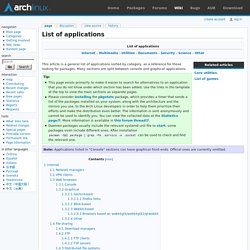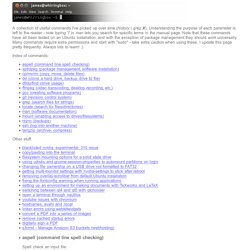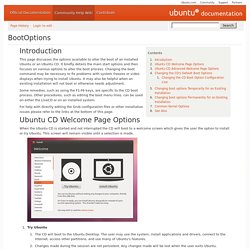

Index page. ATTENTION INFO. List of applications. This article is a general list of applications sorted by category, as a reference for those looking for packages.

Many sections are split between console and graphical applications. Tip: This page exists primarily to make it easier to search for alternatives to an application that you do not know under which section has been added. Use the links in the template at the top to view the main sections as separate pages. Please consider installing the pkgstats package, which provides a timer that sends a list of the packages installed on your system, along with the architecture and the mirrors you use, to the Arch Linux developers in order to help them prioritize their efforts and make the distribution even better. The information is sent anonymously and cannot be used to identify you. Note: Applications listed in "Console" sections can have graphical front-ends. Internet Network managers || connman netctl — Simple and robust tool to manage network connections via profiles. || netctl || systemd. CLI (rsync, dump, etc)
Useful Linux terminal commands (and other settings) A collection of useful commands I've picked up over time (history | grep X).

Understanding the purpose of each parameter is left to the reader - note typing '/' in man lets you search for specific terms in the manual page. Note that these commands have all been tested on an Ubuntu installation, and with the exception of package management they should work universally. Many commands require extra permissions and start with "sudo" - take extra caution when using these.
Official repositories - ArchWiki. Unix Shell. Changing Priority on Linux Processes. How to Manage Processes from the Linux Terminal: 10 Commands You Need to Know. The Linux terminal has a number of useful commands that can display running processes, kill them, and change their priority level.

This post lists the classic, traditional commands, as well as some more useful, modern ones. Many of the commands here perform a single function and can be combined — that’s the Unix philosophy of designing programs. Other programs, like htop, provide a friendly interface on top of the commands. top The top command is the traditional way to view your system’s resource usage and see the processes that are taking up the most system resources. To exit top or htop, use the Ctrl-C keyboard shortcut.
Htop The htop command is an improved top. Sudo apt-get install htop htop displays the same information with an easier-to-understand layout. We’ve covered htop in more detail in the past. ps The ps command lists running processes. Ps -A ps -A | less.
InstallingSoftware. Main page: Ubuntu Documentation: Installing applications.

Note: The Main page is available in multiple languages. Installing software in Ubuntu is easy, and this guide will show you how to do it. By default, many useful programs are already installed when you put Ubuntu onto your computer. However, you may need a particular piece of software that serves a purpose not served by the default applications. You might just want to try an alternative program to one which is already installed.
If you'd like to get some background information on what's happening when you install software (which can sometimes be technical), read Packages and Package Management. See also: FreeSoftwareAlternatives This section covers the basic concepts of packages and package management. What is a package? Software is a very broad term, and is generally taken to mean a program which you can run on your computer. Ubuntu uses packages to store everything that a particular program needs to run. Source or Binary? Use Keryx.
Command line - What is the correct way to completely remove an application? RPM Commands in Linux. "vi" editor command. Commands to check the Linux Version, Release name & Kernel version. How to shutdown Linux at a specific datetime from terminal? VM Sysctl documentation. How to install gdebi? Quote: This is a very good idea.

Very good. Would be nice if you would try it again and simply copy paste EVERYTHING that is on the terminal window. Would also be good to try the command (copy/paste to terminal) You should be asked for your password. If you get an error message on that copy/paste everything on the terminal to here. If you do not get an error copy/paste this to the terminal; Code: apt-get install gdebi. BootOptions. This page discusses the options available to alter the boot of an installed Ubuntu or an Ubuntu CD.

It briefly details the main start options and then focuses on various options to alter the boot process. Changing the boot command may be necessary to fix problems with system freezes or video displays when trying to install Ubuntu. It may also be helpful when an existing installation will not boot or otherwise needs adjustment. Some remedies, such as using the F1-F6 keys, are specific to the CD boot process.
Install a .tar.gz (or .tar.bz2) file? Dependencies Linux issues problems. Set Governors, CPU frequencies, Linux. Errori firme Linux. Linux on UEFI. Linux Keyboard ShortCuts. Linux Mouse configuration. Asciinema.org. Gtk, Styling & Themes. Systemd. Backup, Linux. Linux TouchScreen Support. Linux TouchPad MultiTouch Gestures Support. Hyperlink. Prepare SSD for Linux Ubuntu. Hyperlink. Linux.